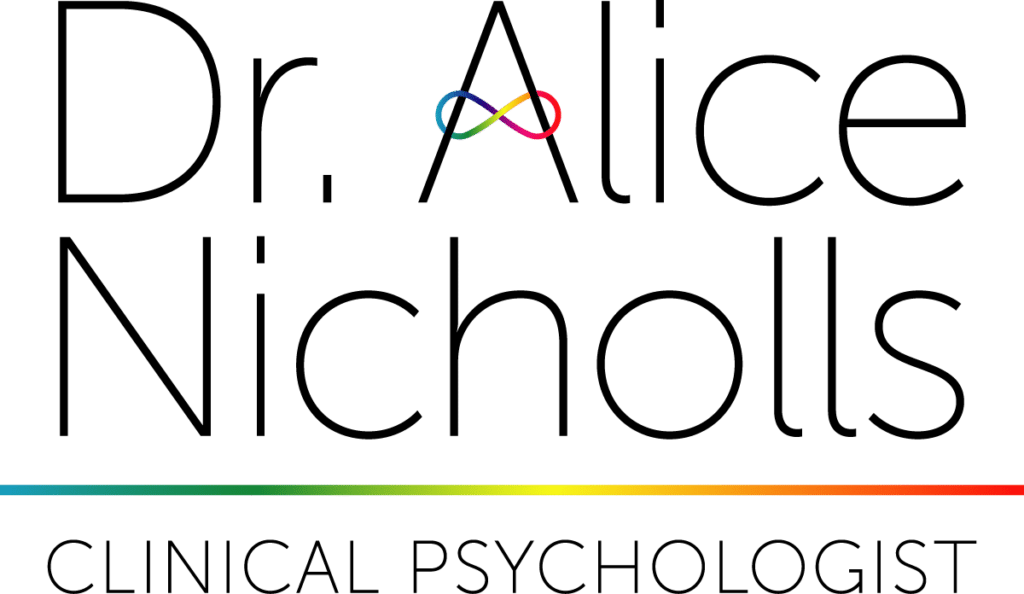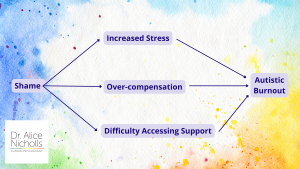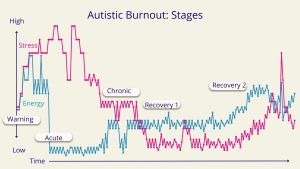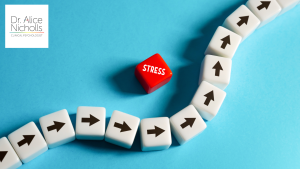In my work with people experiencing Autistic Burnout I’ve noticed a pattern, or, to be more precise a cycle.
This cycle includes Autistic Burnout but I also see it repeated on a smaller level within episodes of Autistic Burnout and on a daily basis for Autistic people too.
In this article I will describe a typical cycle of Autistic Burnout and identify one of the common traps people fall into in their recovery from Autistic Burnout.

High Stress
Often people end up in Autistic Burnout after a period of high stress, this can be long term stress that has gradually increased over time. Often as people’s lives get more complicated and they achieve more they are left with increased responsibilities, less support and less time to engage in soothing and regulating activities.
Stress can have a cumulative effect over years. In these cases there isn’t always an obvious trigger for the Autistic Burnout, or if there is, it may seem relatively minor.
Alternatively, I have also met people in Autistic Burnout who had been experiencing moderate stress in the long term, but then had a highly stressful experience that pushed them into burnout. For example the death of a loved one or pet, childbirth, moving house or getting divorced. For more information on sources of stress please see this article.
Burnout
The onset of Autistic Burnout is normally pretty fast, there may have been warning signs, characterised by fluctuations in functioning and energy levels but there is usually a severe drop in energy, loss of functioning and decreased ability to tolerate unmet sensory needs. For more information on symptoms please see this article.
I’ve noticed that Autistic Burnout seems to have two phases:
- The Acute Phase: when the person’s symptoms are at their peak and their energy levels are at their absolute lowest. This is sometimes accompanied by a physical and/or mental health crisis. This phase may last days or weeks and, less often, months.
- The Chronic Phase: This follows the acute phase and tends not to be as severe, but can last for months or even years. Typically people in this phase regain a small amount of energy and functioning but feel a long way away from their previous level of functioning. This brings with it all sorts of challenges and can be a depressing place to be.
Reduce Stress
Normally the loss of energy and functioning seen in Autistic Burnout cause some of the stressors to reduce. This might be because the person is unable to engage in their usual work and home responsibilities. They withdraw from social activities and their sensory challenges cause them to avoid more than they usually would.
For people unable to escape their sources of stress, (for example those with young children) over time they may find other ways to regulate their stress levels, by engaging in regular soothing activities, accessing more support and finding ways of taking more frequent and effective breaks.
For more information on how to recover from Autistic Burnout please see this article.
Recovery
The reduction in stress, for a prolonged period, leads to a gradual return of energy, skills and tolerance.
I would like to stress that this is often gradual. It is rare that I see a quick fix (although maybe the people who get a quick fix don’t feel the need to find me?).
Increased demands
The apparent recovery, however partial often leads to the Autistic person being exposed to increased demands.
These demands can come from those around the Autistic person or from themselves.
If they are too high they lead straight back to Increased stress and this is where the cycle begins again.
The Common Trap Autistic People Fall Into
In terms of avoiding Autistic Burnout the recovery period can be the riskiest period in the cycle of Autistic Burnout.
Often people are worrying about responsibilites, to do lists and chores that they have not been able to engage with. They can feel a tremendous amount of pressure to re-engage and get things done to make up for their time in burnout or at least prevent new things accumulating.
When the person finally feels they have a bit of energy they can also get excited about what they might be able to do.
This pressure and/or excitement is coupled with a fear that the increase in energy won’t last.
With this pressure and/or excitement it is easy to enter into a mindset of ‘making the most of the energy’.
Autistic people feel slightly energised and then massively overspend their, still largely, depleted energy reserves. This pushes them back into energy debt and Burnout.
For this reason energy crashes, mini burnouts and recovery setbacks are very common in the recovery phase.
The Solution
Small energy gains are a good sign that the Autistic Person is recovering from their Burnout. It is important not to do too much in this phase.
Frustrating as it might be, holding back some energy so there is some left at the end of the day will help to build some reserves and enable the Autistic Person to do more later.
How to help if you are supporting an Autistic Person who has been in Autistic Burnout:
- Be careful not to inadvertently encourage them to do too much with the little energy they have.
- Encourage them to use some of their increased energy on regulating and soothing activities.
- Encourage them to stop before they run out of energy.
- Ask if they would like you to prompt them to stop if they appear to be deeply focused on something.
If you are the Autistic Person:
- Please know that this is a struggle that many of us have. It is difficult but understandable that you might feel frustrated.
- If you can feel your inner critic pushing you to do more try to compassionately remind yourself that ultimately you will be able to do more if you allow yourself to rest and engage in regulating activities.
- Try to end tasks before you start to feel fatigued by them.
- Aim to save 40% of whatever energy you have each day. This will help you to recover and start to build energy reserves.
- Remember there is more than one type of energy and you might have more of one type (e.g. Physical) than another (e.g. Social) .
For more information on Energy Management please see this article.
I am an Autistic Clinical Psychologist specialising in Autistic Burnout if you would like to know more about my work please check out my:
- Mailing list community for people who want to receive helpful information and resources about Autistic Burnout.
- Free short course on How to Break the Cycle of Autistic Burnout (link goes straight to registration page)
- Authenticity Basecamp: A 90 day support programme for people in the early stages of recovering from Autistic Burnout who want to get calmer, clearer and more supported.
- Authenticity: The Course and Community: For late-realised, high-masking Autistic adults who want to build more sustainable, authentic lives and break free of the cycle of Autistic Burnout for good.











